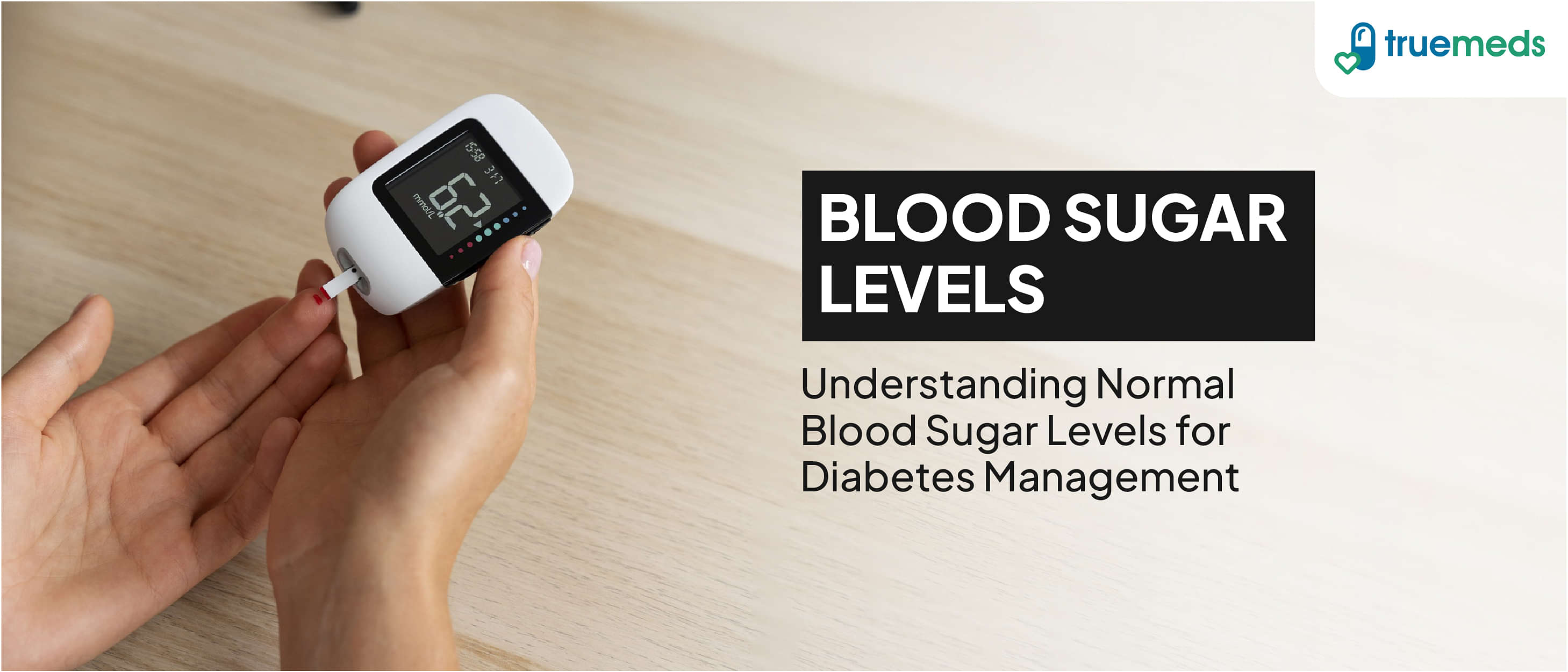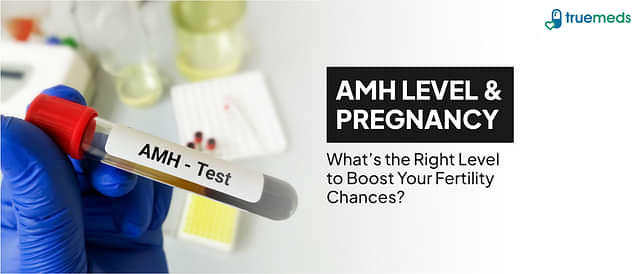Understanding Normal Blood Sugar Levels in Diabetes
Last updated on : 01 Dec, 2025
Read time : 8 min
Diabetes is one of the fastest-growing chronic conditions in India, with over 101 million people currently living with the disease and another 136 million affected by prediabetes [1]. This silent warning sign often goes unnoticed until it progresses.
However, most people don’t realise how easy it is to overlook fluctuations in blood glucose levels. Whether you’re newly diagnosed, at risk, or supporting a loved one, understanding what normal blood sugar looks like is the first step toward taking control.
Knowing your target range can help you manage diabetes more effectively through lifestyle changes, medication, or diet. Regular monitoring allows you to make informed decisions and prevent long-term complications.
In this blog, we’ll break down what normal blood sugar levels look like in prediabetes and diabetes, and how you can monitor them effectively at home.
It is essential to get your blood glucose levels checked and consult a doctor for a proper diagnosis and treatment plan.
What is the Target Blood Glucose Range?
The target blood sugar level for a healthy, non-diabetic person typically ranges between 70 to 100 mg/dL when fasting, and it should be below 140 mg/dL two hours after eating [2]. These levels help keep the body energised without leading to health issues.
Diagnostic Categories for Blood Glucose Levels
Blood glucose levels are typically categorised into three ranges for diagnosis: Normal, Impaired Glucose Tolerance [also known as Prediabetes], and Diabetic. These cut-off values are based on established clinical guidelines for the Fasting Plasma Glucose [FPG] test and the Oral Glucose Tolerance Test [OGTT] [2].
Note on Postprandial Values: The 2-hour Postprandial values [after eating] listed above refer specifically to the Oral Glucose Tolerance Test [OGTT]. In day-to-day self-monitoring, target ranges for people with diabetes are personalized but often aim for less than 180 mg/dL one to two hours after a meal, and 80 to 130 mg/dL before a meal [3]. Always discuss your personal target goals with your healthcare provider.
What is a Random Blood Sugar Test, and How Does it Help Manage Diabetes?
A Random Plasma Glucose [RPG] test measures glucose levels in the blood at any given time, regardless of when or what you last ate [4].
This test is often used as a screening tool. A random blood glucose value of 200 mg/dL or higher, when accompanied by classic symptoms of diabetes [such as frequent urination, increased thirst, and unexplained weight loss], is sufficient to diagnose diabetes [2].
This test helps manage diabetes by providing real-time information about how your body is processing glucose. It helps individuals with diabetes to assess the impact of meals, medications, and lifestyle choices on blood sugar levels. By monitoring these levels regularly, you can adjust your diet, medication, and activity level to keep your blood sugar within a safe range. This proactive approach aids in preventing diabetes-related health complications.
Takeaway: Managing Your Blood Glucose
If you are consistently experiencing symptoms like increased thirst [polydipsia], increased hunger [polyphagia], frequent urination [polyuria], fatigue, weight loss, or slow wound healing, consult a doctor immediately for a screening [5]. Early detection can prevent the severity of the condition and reduce the risk of serious complications such as neuropathy [nerve damage], cardiovascular disease [heart disease and stroke], kidney damage [nephropathy], and vision problems [retinopathy].
Those with pre-existing diabetes should regularly monitor their blood glucose levels. You may use self-monitoring blood glucose [SMBG] meters, Continuous Glucose Monitoring [CGM], and Flash Glucose Monitoring to record your readings [6]. This can encourage you to make informed decisions about your daily meals, activity levels, and medications. Discuss with your endocrinologist to determine the best monitoring method and personalized target ranges for you.
Expert quote
“You don’t need a diagnosis to start paying attention to your blood sugar. Tracking early, even once a month, can give you insights into how your body is responding to stress, sleep, food, and activity long before symptoms appear.”
–Dr. Lakshmi Vaswani
Frequently Asked Questions (FAQs)
Can I check my own blood sugar level?
Yes, you can check your own blood sugar level using a glucometer [or blood glucose meter]. This portable device measures your blood glucose levels from a small drop of blood, usually taken from your fingertip. By regularly monitoring your blood sugar, you can better manage your diabetes and make informed decisions about diet, exercise, and medication. Always follow the instructions provided with your glucometer and consult your doctor for guidance on how often to test and what your personal target levels should be.
Is a blood sugar of 135 mg/dL considered high?
A blood sugar level of 135 mg/dL falls within the prediabetes range [100–125 mg/dL for fasting or 140–199 mg/dL 2 hours after an OGTT]. It indicates impaired glucose tolerance, emphasising the need for lifestyle modifications and monitoring to potentially prevent or delay diabetes progression.
Is a 120 mg/dL sugar level normal after eating?
A blood sugar level of 120 mg/dL one to two hours after eating is generally considered within the normal or healthy range for a non-diabetic individual.
Is a 200 mg/dL sugar level normal?
No, a blood sugar level of 200 mg/dL is generally not considered normal. If a random blood glucose test is 200 mg/dL or higher, or if a 2-hour OGTT is 200 mg/dL or higher, it indicates the presence of diabetes [2]. This value falls into the hyperglycemic range.
What is the normal glucose level for an adult aged 50 years?
There is no specific “normal” blood glucose level based solely on age. The diagnostic cut-offs for fasting [below 100 mg/dL] and 2-hour post-meal [below 140 mg/dL] apply to all adults, including those aged 50. However, for an adult with diabetes, the target range may be slightly adjusted by a doctor based on co-existing health conditions and risk of hypoglycemia [3].
What is the alarming sugar level in pregnancy?
During pregnancy, elevated blood sugar may indicate Gestational Diabetes Mellitus [GDM]. The alarming or diagnostic levels are typically determined using a 75-gram OGTT. The diagnostic cut-offs are when any of the following are met or exceeded [7]:
- Fasting: 92 mg/dL
- 1 hour: 180 mg/dL
- 2 hours: 153 mg/dL GDM needs prompt medical attention and management to reduce risks for both the mother and the baby.
How can I quickly reduce my blood sugar levels?
If blood sugar levels are acutely high [hyperglycemia], the fastest ways to lower them include taking an appropriate dose of prescribed insulin [if you are an insulin user] or engaging in light physical activity like a brisk walk, provided there are no ketones present. It is crucial to never arbitrarily change medication doses and to consult your doctor for a plan to address acute hyperglycemia [6].
What is the first-line treatment for high blood sugar?
The first-line treatment for elevated blood sugar [prediabetes and early Type 2 diabetes] includes therapeutic lifestyle changes, which involve dietary modifications [focused on reducing simple carbohydrates and increasing fiber], regular physical activity, and weight management [8]. For Type 2 diabetes, the medication metformin is commonly the first-line pharmacological treatment.
What is the medicine for high sugar?
Medications for high blood sugar are categorized based on their mechanism of action. These include:
- Biguanides [e.g., Metformin]: Improves insulin sensitivity.
- Sulfonylureas and Glinides: Stimulate the pancreas to produce more insulin.
- DPP-4 Inhibitors: Enhance the body’s natural incretin hormones.
- GLP-1 Receptor Agonists and SGLT-2 Inhibitors: Newer classes that help with blood sugar control and often offer cardiovascular and renal benefits [9]. The specific medicine your doctor prescribes depends on the type of diabetes, its severity, co-existing conditions, and personalized treatment goals.
References
[1] Anjana, R. M., Unnikrishnan, R., Deepa, M., Pradeepa, R., Tandon, N., Das, A. K., … & Elangovan, N. [2023]. Metabolic non-communicable disease health report of India: the ICMR-INDIAB national cross-sectional study [ICMR-INDIAB-17]. The Lancet Diabetes & Endocrinology, 11[7], 474–489. https://doi.org/10.1016/s2213-8587[23]00119-5
[2] American Diabetes Association Professional Practice Committee. [2024]. 2. Classification and Diagnosis of Diabetes: Standards of Care in Diabetes—2024. Diabetes Care, 47[Suppl. 1], S20–S42. https://doi.org/10.2337/dc24-S002
[3] American Diabetes Association Professional Practice Committee. [2024]. 7. Diabetes Technology: Standards of Care in Diabetes—2024. Diabetes Care, 47[Suppl. 1], S156–S170. https://doi.org/10.2337/dc24-S007
[4] Centers for Disease Control and Prevention. [2023, February 1]. Diabetes tests. https://www.cdc.gov/diabetes/basics/getting-tested.html
[5] Mathew, T. K., Tadi, P., & Zubair, M. [2024]. Blood glucose monitoring. StatPearls Publishing. https://www.ncbi.nlm.nih.gov/books/NBK555976/
[6] Centers for Disease Control and Prevention. [2022, December 5]. Monitoring your blood sugar. https://www.cdc.gov/diabetes/managing/managing-blood-sugar/bloodglucosemonitoring.html
[7] American Diabetes Association Professional Practice Committee. [2024]. 15. Management of Diabetes in Pregnancy: Standards of Care in Diabetes—2024. Diabetes Care, 47[Suppl. 1], S282–S299. https://doi.org/10.2337/dc24-S015
[8] American Diabetes Association Professional Practice Committee. [2024]. 5. Facilitating Behavior Change and Well-being to Improve Health Outcomes: Standards of Care in Diabetes—2024. Diabetes Care, 47[Suppl. 1], S79–S101. https://doi.org/10.2337/dc24-S005
[9] American Diabetes Association Professional Practice Committee. [2024]. 9. Pharmacologic Approaches to Glycemic Treatment: Standards of Care in Diabetes—2024. Diabetes Care, 47[Suppl. 1], S199–S223. https://doi.org/10.2337/dc24-S009
Disclaimer
Our healthcare experts have carefully reviewed and compiled the information presented here to ensure accuracy and trustworthiness. It is important to note that this information serves as a general overview of the topic and is for informational purposes only. It is not intended to diagnose, prevent, or cure any health problem. This page does not establish a doctor-patient relationship, nor does it replace the advice or consultation of a registered medical practitioner. We recommend seeking guidance from your registered medical practitioner for any questions or concerns regarding your medical condition.
Popular Articles
Recommended Articles
Recent Articles
Company
About UsHealth ArticleHealth StoriesHealth LibraryDiseases & Health ConditionsAyurvedaUnderstanding Generic MedicinesAll MedicinesAll BrandsNeed HelpFAQSecuritySubscribe
Registered Office Address
Grievance Officer
Download Truemeds
Contact Us
Our customer representative team is available 7 days a week from 9 am - 9 pm.
v4.10.3
2025 - Truemeds | All rights reserved. Our content is for informational purposes only. See additional information.
Our Payment Partners













































